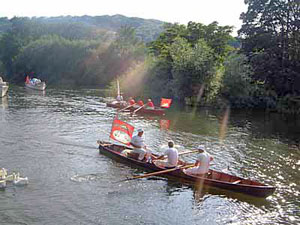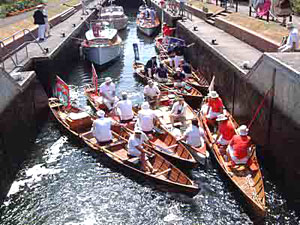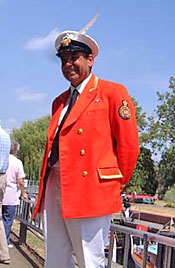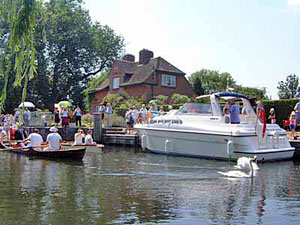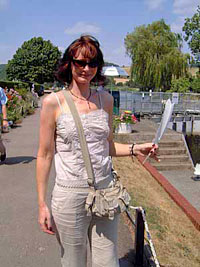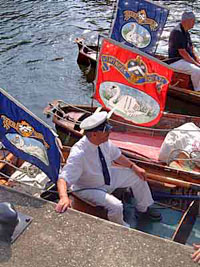|
by Andrew Collins
from
AndrewCollins Website
The Swan-upping flotilla reaches Goring Lock,
Oxfordshire, on 20
July 2006 (Pic: Andrew Collins) Thursday, 20 July. I travelled to Oxford and Berkshire in pursuit of one of the River Thames's oldest traditions, the Swan-upping ceremony, whereby all cygnet swans are weighed and marked during a colourful journey that takes place over five days in July each summer.
The whole thing is conducted by members of two of London's
oldest livery companies, the Vintners and Dyers, who, along with the
monarch's swan-warden, gradually make their way from Sunbury,
Middlesex, to Abingdon in Oxfordshire, capturing any young bird they
might come across. It is a truly royal ceremony, as the reigning
monarch is deemed protector of all swans in Britain. On the Thames
itself, only the Vintners and Dyers are granted the right to own
swans, this being in honour of their annual contribution to the
Swan-upping ceremony.
Officially, Swan-upping began only in the
fifteenth century, but the Royal Windsor website speaks of it going
back as far as the thirteenth century, and I argue in THE CYGNUS
MYSTERY that it is an echo of something much more ancient, when the
city's vintners came under the jurisdiction of the Roman temple of
Isis, the inventor of wine, whose avataristic forms included the
swan and goose. Moreover, the Vintners' Martinmas feasts held each
year in honour of the swan resonate with pre-Christian traditions
that saw this bird as the carrier of souls into the next world.
Swan-upping flotilla awaits the opening of Mapledurham
Lock
Very quickly the whole
armada was trailing away into the distance on their way now to
Goring Lock, the Thames oldest crossing point. The two swans were
still present, moving gracefully through the water in front of us,
when unexpectedly one of them reared up its wings, stuck out its
serpentine neck and head, and began making an awful cacophony.
What a fine gift for the day - a feather straight from the back of one of the swans that had led the Swan-uppers out of the lock. It was an act that in the past would have been seen as particularly fortuitous by those belonging to a shamanic based society. I stuck it in my hat, and with the sun shining we moved on to the next site.
Two swans lead out the Swan-upping flotilla from Mapledurham Lock
We had meant to catch up with the Swan-upping flotilla in Goring-on-Thames, Oxfordshire, but passing a riverside pub, appropriately named The Swan, in Pangbourne, Berkshire, I suddenly noticed the blue and red flags of the Dyers and Vintners, and realized that they had stopped for a much needed pint and some lunch. This was odd as Sue and I had come across this pub in January, and thought then that it would be a great place to await the Swan-upping flotilla.
Now they were here, and so we ordered our
own food and drinks, and absorbed the vibrant atmosphere. I talked
to the Clerk of the Vintners Company about THE CYGNUS MYSTERY, and
chatted to one man whose father had a very unique job in the
Swan-upping process. He rides ahead of the skiffs on a bike looking
for any cygnets. When he finds one he keeps watch over it until the
flotilla arrives.
What was once a coat of
skin and swans' feathers worn by the shaman was today the decorative
dress of the swan-wardens and swan-markers.
The Swan-marker for the Dyers Company sits in his skiff at Goring Lock, the flags of both livery companies clearly in view
We arrived home late, and just as we got out of the car Sue said
that to make the day complete it would be great to see one of the
Alpha Cygnids, meteors that appear to come from Deneb, the brightest
star in Cygnus. They reach their maximum number per hour on 18 July,
which has always made this astronomical firework display strangely
coincident to the Swan-upping ceremony on the Thames each year. At
that very moment a bright streak emerged from Cygnus and shot
northwards, a perfect end to a wonder day.
|

